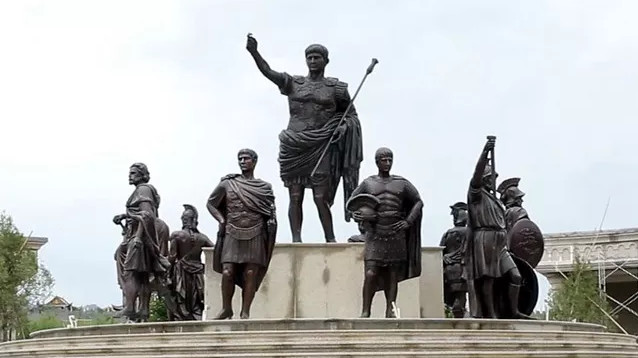Evidence shows that Roman soldiers went to war in China?
Li Yi, a small Chinese village, is nothing special except for the ancient Roman architecture, the famous Roman statues, and the blonde-eyed blond people in La soldier costumes. Code.
Ancient Roman soldiers went to war to China?
On the edge of the Gobi Desert, Yongchang District, Jin Xuong District, Gansu Province in the People's Republic of China, there is a village called Li Su . A village in a remote place, nothing special. Except for the ancient Roman architecture, the famous Roman statues, and the blue-eyed blond people in Roman soldiers' costumes.

Statues at Li Su.
Li Su village is located on a land that was once Lu Li town. There is nothing special if the people here look like all Chinese people - but not: snub, white skin, blond hair, blue eyes, which are the characteristics we can see. At the people of Li Su. These are the characteristics of the Caucasoid race - the 'white' strain - clearly not native. Homer Hasenpflug Dubs - Chinese professor at Oxford, translator Han English version - in 1941 raised a controversial hypothesis to this day that the town of Li Su was founded by the Romans. lose.

What made you propose such a bold hypothesis? First we need to consider some strange coincidences in historical developments when Li Li was founded under the Han Dynasty.
1. The name of the Case
Through Hau Han Thu and many other records, we know that the Chinese during the Han Dynasty knew the Roman empire, and gave Rome at least three names: Dai Qin with Roman connotation of China of Western, Hai Tay - West of the big sea, and Li Kien (or Le Kien ). Is this just a coincidence, or, according to Professor Dubs's theory, is the fact that Li Su and the Roman empire are connected?
2. Time of establishment
Li Kien town appeared on the map in 5 AD, but not in the records in 79 BC. In the western continent, in 53 BC, the Roman army under the command of Marcus Licinius Crassus defeated the Parthians in the battle of Carrhae. A large number were captured, some fled and unknown. According to Professor Dubs, during the following period, it is possible that some Roman soldiers wandered to the East (on the run or after being released by the Parthians). They became mercenaries for the Hungarians, and led to a third coincidence: the Battle of Taraz in 36 BC.

Battle of Carrhae, 53 BC.
3. Battle of Taraz, 36 BC
In 36 BC, in present-day Talas, Kazakhstan, there was a fierce battle between the Han army and the Hungarians under the leadership of Zen monk Chi Chi, ending with the Han victory. More specifically, Han Shu mentioned 145 soldiers who were in the ranks of the Hungarian army, battling the 'fish scales' formation - a formation that Professor Dubs thinks is actually the famous Testudo squad of the army. Roman . He said that these soldiers were Roman mercenaries, and after falling into the hands of Han people, were relocated to the East to form Li Su town.

Journey of the Roman soldiers in Professor Dubs's theory.
'Numquam ponenda est sine necessitate' - Lex parsimoniae
'Always avoid unnecessary complications' - the motto in dealing with William of Ockham's situation, is called lex parsimoniae or 'Ockham razor' . In explaining the causes of things, this means that the hypotheses are as simple as possible, and the assumptions that have many unrelated coincidences are even more unlikely. According to lex parsimoniae, the simple and logical hypothesis is that of Professor Dubs, that the people at Li Su are really the descendants of the defeated Roman.
A 1.8-meter-tall skeleton was found when excavating the remains of the Old Town town - an unusual height for a Chinese resident. This skeleton dates back about 2000 years, coinciding with the time of the town's establishment, and thus fits Professor Dubs's theory. There are also some interesting details such as the graves here all turn to the West, the people of Li Suu often organize a form of 'bullfighting' - for 2 bulls to fight each other to death - a hobby 'Roman' part control .

However, genetic investigations in Li Li residents and archaeological work, for decades, with the association of archaeologists from many places, recently the link between Italy and China, is still not can give any convincing evidence for Professor Dubs's hypothesis. The study shows that 56% of residents carry the gene for the Caucasoid strain, but it is impossible to determine whether it is the word "Romans" (Romans refer to Roman citizens, citizens of an empire.) There is no concept of 'Roman people' .
On the Silk Road and Central Asia steppe, as well as in the nomadic army in the region, whites are not rare. Another study in 2007 found that 77% had close ties with indigenous peoples, mainly Han. So far, no relics are typical of Roman soldiers found in the region. However, there is no evidence to reject Professor Dubs' hypothesis, and the argument continues.

Meanwhile, people and authorities in Li Yi have found a new source of income from curious tourists.
- Discover the ancient Roman military road
- The death penalty of nearly 1,000 Jews before 5,000 Roman soldiers in 70
- American power transmission into the brain soldiers to increase focus
- China unearthed hundreds of clay soldiers
- Bath house - a Roman dating place
- The warm summer makes the Roman Empire prosper
- New discovery: Malaria appears from the Roman Empire
- Smart soldiers easily die
- Confused about the sexual assault, the tyranny of Roman times
- Roman army defeated 8,000km lost to China?
- Life of a citizen of the Roman Empire in ancient times: Every day must survive
- Discovering a vestige of a Roman theater underfoot
 Biography of hero Vu A Dinh
Biography of hero Vu A Dinh History of hematology
History of hematology Who is Mr. Tam Da 'Phuc-Loc-Tho' and what does it mean?
Who is Mr. Tam Da 'Phuc-Loc-Tho' and what does it mean? Unbelievable facts about the history of the oil and gas industry: Gasoline used to be cheaper than water, so abundant that it had to be dumped into the river...
Unbelievable facts about the history of the oil and gas industry: Gasoline used to be cheaper than water, so abundant that it had to be dumped into the river... 1,800-year-old shield reveals the glory days of the Roman Empire
1,800-year-old shield reveals the glory days of the Roman Empire  Rare gladiator knife handle found on Hadrian's Wall
Rare gladiator knife handle found on Hadrian's Wall  Revealing the uses of Roman dodecahedron discovered in Belgium
Revealing the uses of Roman dodecahedron discovered in Belgium  Rare Roman-era coin hoard discovered in German mountains
Rare Roman-era coin hoard discovered in German mountains  What was the fate of the city destroyed for opposing the Roman Empire?
What was the fate of the city destroyed for opposing the Roman Empire?  Excavation of 1,700-year-old Roman ruins on top of a sacred spring
Excavation of 1,700-year-old Roman ruins on top of a sacred spring 